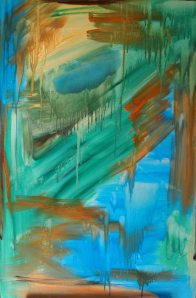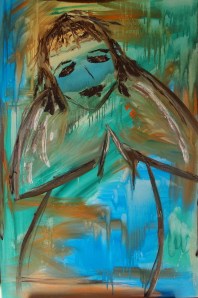Initially, I wasn't going to share my homework assignment for this week, as in truth, I didn't really manage to execute the task properly.
The ground and the figure are separate in my work and DeKooning 's figures were very much merged with the ground. It will take longer than a week to fully grasp how to paint in this way. I did learn about turpentine burn and other techniques though, and this weeks challenge brought out something in me that I really enjoyed. So, although this assignment didn't work out entirely correct, it taught me something new about myself and allowed me to just 'lay on the paint' thick and then scrape it off entirely to begin again on a stained ground. This is something I had never contemplated doing before. It was quite liberating!
This started out as the most difficult week for me. I didn't much about what I had heard about DeKooning as a man and I didn't like his painting 'Woman 1', in fact it wasn't until we started to study the exploratory nature of how DeKooning related to his art that I felt any kind of connection at all. I recently went to MoMA in NYC and had the pleasure of seeing 'Woman 1' after our classes had finished and I know I saw an entirely different picture than I would have without having studied his work with Corey D'Augustine's infectious enthusiasm for DeKooning's painterly skill! I came to learn new techniques like turpertine burn (basically dipping a rag in terps and wiping off the paint just applied, the remaining stain is known as turperntine burn) and be guided through the visual unwinding of the process by which these works were made. It gave me a deep appreciation for passion DeKooning must have felt for his paint and the act of painting.
His marks are very gestural, leaving a path of paint that is a visual record of the movement required to make it. They are lyrical paintings and the methods he used in applying the paint and the experiments with the materials themself leave a lot to chance in the way different applications affect each other. A wet on wet application leads to interaction between the paints that one can't plan. Pools of mixed color and swirls of one color bleeding into another , rivulets forming and canals digging through an already painted surface are some of the delightful surprises for an artist painting this way.
On a personal level, this gets me, I could spend hours watching paint dry! So, although I don't respond to the subject matter in DeKooning's most famous works (mainly the 'Woman' series) I thoroughly feel a kindred passion for his dedication to exploring paint. DeKooning was one of those artists who explored the potentials of his materials in his work. He is known for mixing oils with egg yolk, ( to emulsify, as in Tempera) and water (it froths), even mayonnaise (it separates), just to see what would happen with the paint on the canvas.
I like the freedom in this exploratory nature, it is evident in his mark making also. Having said that, I personally prefer his later work, painted with the onset of Alzheimer's. It would appear he attained the ultimate freedom (restriction of subject and minimal palette) and made beautifully elegant works based on fluid, curvaceous, flowing lines that float without the need of structured composition. The style directly linked to the same type of gestural marks he made with his brush strokes in his early work but without the format or the subject. There is a spacious feel to them, as though they are flowing directly from his subconscious and executed naturally within the repertoire of strokes that became his language.



